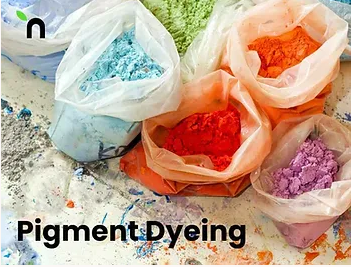1. Direct Dyeing Method
Direct dyeing is a straightforward and widely used approach, especially for cotton T-shirts which are prevalent in the market. The principle behind it lies in the affinity of the direct dyes for cellulose fibers, which make up the majority of cotton fabric.
To begin the process, the dye, in powdered or liquid form, is dissolved in warm water within a large dye vat, creating a dye solution with the appropriate concentration. The T-shirt fabric, which has undergone preliminary treatment to remove impurities and ensure better dye absorption, is then immersed into the dye bath. Agitation is crucial during this stage, either through mechanical stirring devices or by manual manipulation, to guarantee that every part of the T-shirt comes into contact with the dye evenly. The fabric soaks in the dye for a specific period, typically ranging from 30 minutes to a few hours, depending on the desired depth of color. Once the dyeing time elapses, the T-shirt is removed from the vat and subjected to rinsing processes. Multiple washes with clean water help to remove any unfixed or excess dye, known as the “floating dye,” until the water runs clear. Subsequently, a fixation step may be involved, which could be as simple as drying the T-shirt in air or through a mild heat treatment in a dryer. This method is favored for its simplicity and relatively low cost, enabling manufacturers to produce a vast quantity of solid-colored T-shirts with bright and vivid hues.

2. Reactive Dyeing Method
Reactive dyeing has gained significant popularity in recent decades, especially for T-shirts made of natural fibers like cotton, linen, and also for some blends containing cellulose. The unique aspect of reactive dyes is their ability to form a covalent bond with the fiber molecules during the dyeing process, leading to excellent colorfastness properties.
The process commences with the preparation of the dye bath, similar to direct dyeing, but with the addition of specific auxiliaries such as soda ash and salt. Soda ash helps to adjust the pH level of the solution to an alkaline range, which is essential for activating the reactive groups present in the dye molecules. The T-shirt fabric is then added to the dye bath and agitated continuously. The reactive dye molecules penetrate the fiber structure and chemically react with the hydroxyl groups (-OH) present in cellulose under the alkaline conditions. This reaction takes place over a period of time, usually accompanied by maintaining the temperature of the dye bath within a particular range, often between 60 to 90 degrees Celsius. After the reaction is complete, thorough rinsing is carried out to eliminate unfixed dye. This is followed by a soaping process, where the T-shirt is washed with a mild detergent to further improve colorfastness and remove any residual impurities. Reactive dyeing allows for a broad spectrum of colors to be achieved, from pastel shades to deep, intense tones, and the resulting T-shirts can withstand multiple washes without significant fading, making them highly desirable in the market.

3. Pigment Dyeing Method
Pigment dyeing offers a distinct alternative, suitable for a variety of fabric compositions including cotton and synthetic blends used in T-shirt production. Unlike the previous methods that rely on the dyes chemically bonding or having an inherent affinity for the fibers, pigment dyeing involves the use of pigments that are insoluble in water and are held onto the fabric surface through a binder.
The pigments, in the form of fine powders or dispersions, are mixed with a binder solution, which typically contains resins and other additives that help in adhesion and fixation. The resulting pigment mixture is then applied to the T-shirt fabric, either through a padding process where the fabric passes through rollers impregnated with the pigment-binder mixture, or by a spray application method. Once the pigment is evenly distributed on the fabric surface, the T-shirt is subjected to a curing process. This involves heating the fabric to a specific temperature, usually between 150 to 180 degrees Celsius for a set period, which causes the binder to polymerize and firmly attach the pigments to the fabric. Pigment dyeing provides unique visual effects such as a soft, matte finish and the ability to create complex color blends and prints. It is also relatively quick and efficient, making it suitable for mass-produced T-shirts where customization and a variety of color options are required, although the colorfastness might not be as high as that achieved through reactive dyeing in some cases, but still meets the standards for regular wear and tear.

In conclusion, these three dyeing methods – direct, reactive, and pigment dyeing – each possess their own advantages and are carefully selected by T-shirt garment manufacturers based on factors such as fabric type, desired color outcome, cost considerations, and market demands. Their combined application allows for the creation of the rich tapestry of T-shirt colors and styles that consumers enjoy today.

